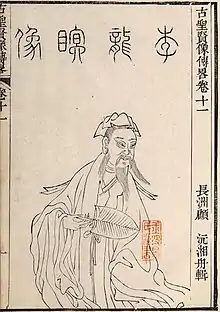

Li Gonglin (李公麟, 1049–1106), style name Boshi (伯時), art name Longmian Jushi (龍眠居士, Householder of Sleeping Dragon), was a Chinese antiquarian, painter, and politician during the Northern Song Dynasty.
Biography
Born into a scholarly home near what is modern day Lu'an City, Li Gonglin passed the highest level of civil service examinations at 21 and became a civil officer. He moved to serve at the capital of Kaifeng; a common path at the time. It was there that he became increasingly familiar with the literary figures of the day, both collecting and copying their works.[1]
Artistic Endeavors
He became famous for his paintings of horses, then he turned to Buddhism and Taoism religious painting, as well as portrait and landscape painting. His painting style was attributed to the style of Gu Kaizhi and Wu Daozi. He made antiquarian contributions in the areas of copperware and Jade Seal dated between the Xia Dynasty and the Zhou Dynasty.[2]
References
- ↑ "Li Gonglin | Song Dynasty, Landscape Art, Calligraphy | Britannica". www.britannica.com. Retrieved 2023-11-23.
- ↑ Harrist, Robert E. (1995). "The Artist as Antiquarian: Li Gonglin and His Study of Early Chinese Art". Artibus Asiae. 55 (3/4): 237–280. doi:10.2307/3249751. JSTOR 3249751.
Further reading
- Barnhart, Richard (1993). Li Kung-lin's Classic of filial piety. New York: The Metropolitan Museum of Art. ISBN 0870996797.
External links
- Li Gonglin and his painting gallery at China Online Museum
- Three handscrolls by Li Gonglin in the collection of the Metropolitan Museum, New York
